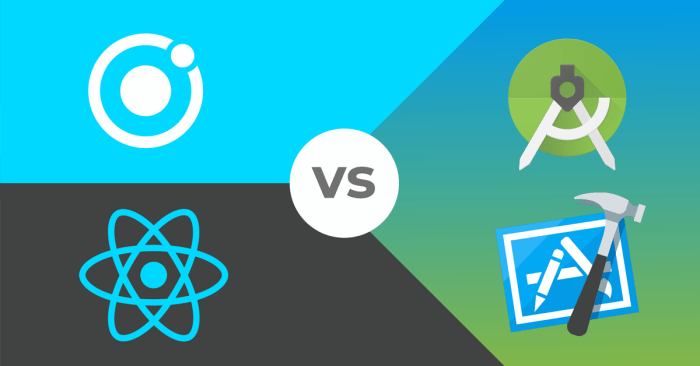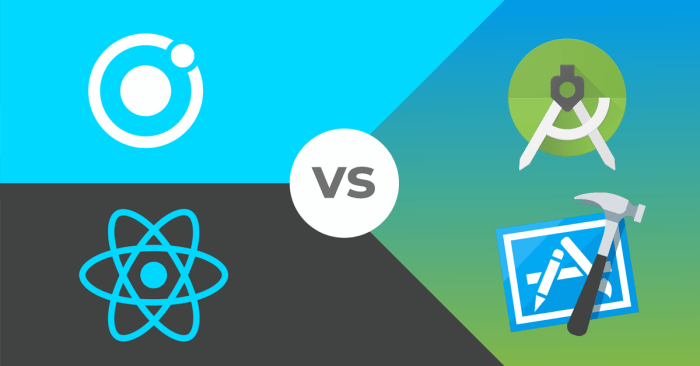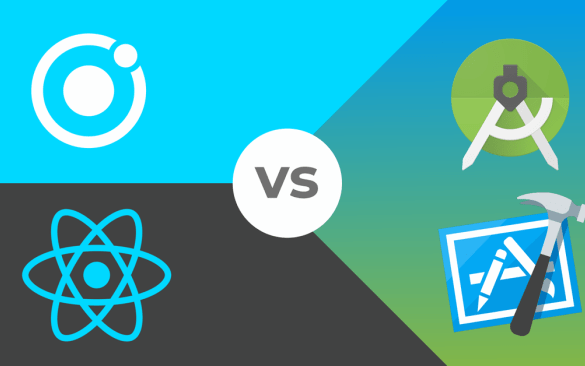Native vs hybrid vs cross platform which one to choose – Native vs hybrid vs cross-platform which one to choose sets the stage for a deep dive into mobile app development. Each approach offers unique advantages and drawbacks, impacting everything from performance and cost to scalability and maintenance. We’ll explore the core principles, performance considerations, development timelines, and future implications of each method, helping you make an informed decision for your next mobile project.
This comprehensive guide compares native, hybrid, and cross-platform development, examining their strengths and weaknesses. From understanding the development environments and workflows to evaluating performance metrics and long-term scalability, this analysis provides a clear picture of which approach aligns best with your specific needs.
Introduction to Mobile Development Approaches
Building mobile applications has become increasingly complex with the proliferation of devices and operating systems. Developers face choices regarding the best approach for creating apps that function seamlessly across various platforms. Understanding the differences between native, hybrid, and cross-platform development is crucial for making informed decisions and achieving optimal results.
Overview of Mobile Development Approaches
Mobile development encompasses a variety of strategies, each with its own strengths and weaknesses. Native applications are developed specifically for a particular platform, like iOS or Android. Hybrid apps utilize web technologies (HTML, CSS, JavaScript) packaged within a native container, while cross-platform approaches aim to build apps that run on multiple platforms using a single codebase. Each approach offers unique benefits and drawbacks that influence the project’s feasibility, cost, and development time.
Native Development
Native apps are tailored to a specific platform (iOS or Android). This approach allows for direct access to device hardware and APIs, leading to enhanced performance and user experience. Developers use platform-specific languages like Swift (iOS) and Kotlin/Java (Android), which are well-suited for interacting with the native environment.
Hybrid Development
Hybrid apps leverage web technologies (HTML, CSS, JavaScript) wrapped within a native container. This allows for a single codebase, potentially reducing development time and costs. However, access to native device features might be limited, impacting performance and user experience. The native container provides a framework for interaction with the platform.
Cross-Platform Development
Cross-platform frameworks allow developers to create applications that run on multiple platforms using a single codebase. This often involves using languages like React Native, Flutter, or Xamarin. The goal is to achieve a balance between efficiency and performance, though it can introduce trade-offs. This approach seeks to reduce development time and maintain consistent user interfaces across platforms.
Comparison of Development Approaches
| Approach | Environment | Workflow | Key Characteristics |
|---|---|---|---|
| Native | Platform-specific IDEs (e.g., Xcode for iOS, Android Studio for Android) | Development tailored to each platform, requiring separate codebases for iOS and Android. | High performance, optimal user experience, direct hardware access, but higher development costs and longer development times. |
| Hybrid | Web development tools (e.g., VS Code, WebStorm), along with native packaging tools | Develop the core application logic in web technologies, then package it into a native wrapper. | Reduced development time and costs for similar functionality, but potentially compromises performance and user experience. |
| Cross-Platform | Cross-platform frameworks (e.g., React Native, Flutter) and their associated IDEs | Develop once, deploy to multiple platforms. | Balancing of efficiency, performance, and platform compatibility. Reduced development time compared to native, but may have performance tradeoffs depending on the framework. |
Performance Considerations
Performance is a critical factor in mobile app development. A sluggish app can lead to user frustration and ultimately, a poor user experience. Understanding the performance implications of different development approaches is essential for building high-performing apps. This section delves into the performance trade-offs of native, hybrid, and cross-platform approaches, providing insights into their strengths and weaknesses.Native apps, while often praised for performance, can be resource-intensive to develop.
Hybrid and cross-platform solutions offer a balance between development time and performance, but come with their own set of considerations. Evaluating performance benchmarks and understanding potential bottlenecks is key to making informed decisions.
Native App Performance
Native apps are built using the platform’s native programming languages (like Java for Android and Swift/Objective-C for iOS). This allows for direct interaction with the device’s hardware and operating system.Native apps leverage the device’s capabilities efficiently, resulting in excellent performance. They can fully utilize the device’s processing power, graphics capabilities, and access to hardware features like the camera or GPS.
This direct access often translates to a smoother user experience and improved responsiveness.
Hybrid App Performance
Hybrid apps utilize web technologies (HTML, CSS, JavaScript) packaged within a native container. This approach allows for faster development cycles, but it comes with performance implications.A potential bottleneck in hybrid apps is the interpretation of web code within a native environment. This can introduce overhead, leading to slower load times and reduced responsiveness, especially for complex interactions or graphics-intensive tasks.
The reliance on web technologies often limits access to advanced device features, impacting performance in scenarios requiring direct hardware access.
Cross-Platform App Performance
Cross-platform frameworks, like React Native or Flutter, aim to bridge the gap between native and hybrid approaches. These frameworks offer the potential for faster development compared to native development, but performance still needs careful consideration.Cross-platform apps often rely on rendering engines or virtual machines that translate the code into native instructions. This intermediate step can introduce performance overhead, especially if the app requires extensive computation or complex animations.
Performance can vary based on the specific cross-platform framework and the complexity of the application.
Performance Benchmarks
Direct comparisons of performance benchmarks across different approaches are complex. Performance is significantly influenced by the specific app’s functionality, complexity, and the underlying hardware.
| App Type | Load Time (avg.) | Responsiveness | Resource Usage | Development Time |
|---|---|---|---|---|
| Native | Fast | Very Responsive | High | Long |
| Hybrid | Moderate | Moderate | Moderate | Short |
| Cross-Platform | Fast (with optimization) | Responsive (with optimization) | Moderate | Medium |
This table offers a general comparison, highlighting the trade-offs between development time and performance for each approach.
Performance Bottlenecks in Hybrid and Cross-Platform Apps
Hybrid and cross-platform apps often face performance bottlenecks stemming from the bridge between web technologies and native functionality.Complex animations or graphics-heavy tasks can be rendered less efficiently in hybrid or cross-platform applications compared to native counterparts, potentially leading to lag or slowdowns.Network dependencies can also impact performance in hybrid apps, especially when the application relies heavily on server communication.
Development Costs and Time: Native Vs Hybrid Vs Cross Platform Which One To Choose

Choosing the right mobile development approach significantly impacts the project’s budget and timeline. Factors like project scope, desired features, and team expertise all play crucial roles in determining the overall cost and time commitment. Understanding these nuances allows for informed decisions and realistic expectations.Developing a mobile application involves a range of expenses, from initial design and coding to testing and deployment.
The selection of development methodology – native, hybrid, or cross-platform – directly influences the financial outlay. This section delves into the typical costs and timelines associated with each approach, providing a comprehensive comparison.
Typical Development Costs
The cost of mobile app development varies widely based on the complexity and features. Native development, while offering optimal performance, often entails higher upfront costs due to the need for dedicated teams for each platform (iOS and Android). Hybrid and cross-platform solutions, conversely, may have lower initial investment but could incur hidden costs later in the project due to performance issues or compatibility issues.
Thorough estimations are essential to account for these potential discrepancies.
Time Commitment Required
The time required for each approach also varies. Native development typically requires a longer timeline as it necessitates separate development for each platform. Cross-platform solutions can shorten development time, especially for applications with basic functionalities. However, unforeseen issues or performance bottlenecks can extend the development period.
Factors Influencing Development Time and Cost
Several factors influence the development time and cost of a mobile application. Project complexity, the sophistication of features, the number of platforms targeted, and the team’s expertise all contribute significantly. Choosing the right tools and technologies also affects the development process. Detailed planning, clear communication, and effective project management strategies are crucial for controlling both time and budget.
Comparison of Development Costs and Timelines
| Project Scope/Features | Native Development (Estimated) | Hybrid Development (Estimated) | Cross-Platform Development (Estimated) |
|---|---|---|---|
| Basic App with core features | $30,000 – $60,000 (3-6 months) | $15,000 – $30,000 (2-4 months) | $10,000 – $25,000 (2-5 months) |
| App with advanced features, multiple platforms | $60,000 – $150,000 (6-12 months) | $30,000 – $75,000 (4-8 months) | $20,000 – $60,000 (5-10 months) |
| Complex App with complex UI/UX, multiple features, integrations | $150,000+ (12+ months) | $75,000+ (8+ months) | $60,000+ (10+ months) |
Note: These are estimations and can vary significantly based on the specific project requirements.
Maintenance and Updates
Maintaining mobile applications requires ongoing effort to address bugs, implement improvements, and adapt to evolving user needs and platform changes. This aspect is crucial for ensuring the long-term success and relevance of any mobile application. Different development approaches necessitate distinct maintenance strategies.The choice of development approach significantly impacts the complexity and cost of maintaining an application over time.
Choosing between native, hybrid, and cross-platform app development can be tricky. It really depends on your project’s needs. For example, if you’re looking to maximize your brand’s presence on Reddit, a platform that’s highly effective for engagement, you might want to consider the webinar, “ready to make reddit work for your brand webinar” ready to make reddit work for your brand webinar , to help you strategize.
Ultimately, the best approach often involves understanding your target audience and the features you need for a successful application, which influences your decision on native, hybrid, or cross-platform development.
Understanding the maintenance procedures and update processes for each approach is vital for informed decision-making. This section delves into the specifics of maintenance and update procedures for native, hybrid, and cross-platform applications.
Native Application Maintenance
Native applications are built using platform-specific languages and frameworks. This approach offers a highly performant experience tailored to the specific device. However, maintaining these applications requires dedicated expertise for each platform.Maintenance procedures often involve debugging, addressing platform-specific issues, and integrating new features or functionalities. Maintaining native applications frequently requires a team of developers specializing in the particular platform languages and frameworks.
For example, maintaining a native iOS app requires developers familiar with Swift or Objective-C, while Android maintenance needs expertise in Java or Kotlin.
Choosing between native, hybrid, or cross-platform development can be tricky. Ultimately, the best approach depends on your project’s needs. However, regardless of your choice, remember that a responsive website design is critical for a positive user experience. This is crucial for reaching a wider audience and ensuring your site looks great on any device. Check out crucial reasons why your website must have responsive design to learn more.
So, while the initial development choice is important, prioritizing a responsive design will make all the difference in the long run for any of these development types.
Hybrid Application Maintenance
Hybrid applications leverage web technologies (HTML, CSS, JavaScript) combined with native platform components. This approach provides a balance between cross-platform compatibility and performance. However, maintenance complexity varies depending on the extent of native integration.Maintenance often involves managing the web view, ensuring compatibility with the platform’s native components, and handling updates to the web application codebase. Addressing platform-specific issues can require more time and effort in a hybrid application, as the web view and native interactions need to be carefully considered.
The interplay between web and native code can introduce potential complexities during updates.
Cross-Platform Application Maintenance
Cross-platform frameworks abstract away platform-specific details, allowing developers to write code once and deploy to multiple platforms. This approach reduces development time and costs. However, maintaining cross-platform applications can present challenges related to compatibility and platform differences.Maintenance involves addressing compatibility issues across different platforms and managing the framework’s updates. Ensuring consistent functionality and performance across platforms during updates requires careful testing and validation.
The framework’s evolution and the potential for inconsistencies between versions can add complexity to maintenance.
Maintenance Strategies Comparison
| Maintenance Approach | Maintenance Strategy | Timeline | Resource Allocation |
|---|---|---|---|
| Native | Platform-specific expertise required, potentially higher initial cost but better performance and control. | Variable, depending on feature complexity and bug severity. | Dedicated developers for each platform. |
| Hybrid | Balance between web and native expertise, potentially lower initial cost than native but higher than cross-platform. | Variable, depending on the complexity of the web view and native interactions. | Developers with web and platform-specific skills. |
| Cross-Platform | Requires framework expertise, lower initial cost and faster development, but potential for compatibility issues. | Variable, depending on framework updates and platform variations. | Developers with framework and basic platform knowledge. |
Features and Functionality

Choosing the right mobile development approach hinges on understanding the strengths and weaknesses of each method. Native, hybrid, and cross-platform solutions each offer unique capabilities, influencing the features and functionalities achievable. This section delves into the specific functionalities each approach excels at and identifies the limitations inherent in each.
Native Application Features
Native applications, developed using platform-specific languages (like Java for Android and Swift for iOS), are known for their performance and direct access to device hardware. This direct access allows for a richer user experience, leveraging features like camera, GPS, and sensors with exceptional responsiveness. The applications are generally more performant and offer a native look and feel, resulting in a higher quality user experience.
- Excellent Performance: Native apps benefit from the optimization inherent in the platform-specific codebase. This leads to smoother interactions and reduced loading times. For instance, a game requiring high-level graphics or frequent updates to sensor data would be more suited to a native application.
- Direct Hardware Access: Native applications have complete access to device hardware, providing capabilities unavailable to hybrid or cross-platform applications. This is crucial for tasks demanding precise control over sensors, such as medical monitoring apps or augmented reality experiences.
- Enhanced User Experience: Native apps provide a native look and feel, integrating seamlessly with the platform’s design principles. This contributes to a more polished and user-friendly experience.
Hybrid Application Features
Hybrid applications use web technologies (HTML, CSS, JavaScript) packaged within a native container. This approach allows for faster development cycles compared to native development, since developers can leverage existing web development skills. However, they typically lack the performance and hardware access of native apps.
- Faster Development: The use of web technologies allows for a faster development process, making it easier to build and deploy an application for multiple platforms. This accelerated development process is particularly beneficial for applications with a more straightforward functionality set.
- Cross-Platform Compatibility: Hybrid apps can target multiple platforms with a single codebase, reducing development time and costs. This approach is ideal for applications with a minimal reliance on platform-specific features.
- Maintenance Challenges: Maintaining a consistent user experience across different platforms can be challenging. Issues arising from the limitations of the web view, or inconsistencies in rendering across devices, may require significant effort to address.
Cross-Platform Application Features
Cross-platform frameworks (like React Native, Flutter) provide a bridge between native and web technologies. They use a single codebase to target multiple platforms, streamlining development. However, the performance might be slightly compromised compared to native applications, and access to certain hardware features might be restricted.
- Single Codebase for Multiple Platforms: This approach significantly reduces development time and effort, as developers can use a common codebase for different platforms. This is especially beneficial for applications that require similar functionality across various platforms.
- Reduced Development Time: Developing for multiple platforms simultaneously is considerably faster compared to native development. This efficiency is crucial for projects with tight deadlines or limited resources.
- Performance Trade-offs: While cross-platform solutions have improved significantly, they might not match the performance of native applications. Certain operations may require more processing time or resource allocation, particularly for complex tasks or graphics-intensive applications.
Functionality Comparison Table
| Feature | Native | Hybrid | Cross-Platform |
|---|---|---|---|
| Performance | Excellent | Moderate | Good |
| Hardware Access | Full | Limited | Limited |
| Development Time | High | Low | Medium |
| Development Cost | High | Low | Medium |
| Cross-Platform Compatibility | Low | Moderate | High |
| User Experience | Native | Web-like | Native-like |
Target Audience and Use Cases
Choosing the right mobile development approach hinges significantly on understanding your target audience and the specific use case. A well-defined target audience, along with a clear understanding of the app’s intended function, directly impacts the optimal development strategy. Whether you opt for native, hybrid, or cross-platform development, aligning the chosen technology with your project’s requirements is crucial for success.
Ideal Use Cases for Native Apps
Native apps, built specifically for a particular platform (iOS or Android), excel in scenarios demanding optimal performance and seamless integration with the platform’s features. This approach provides the most direct access to device capabilities and APIs, enabling developers to create highly responsive and engaging user experiences.
- High-performance games and applications: Native apps can leverage platform-specific hardware and APIs to create smooth, responsive experiences, particularly crucial for games and demanding applications like photo editing or video players. For example, a real-time strategy game would benefit greatly from native development to ensure a fast, fluid gameplay experience, as would an app requiring high-quality graphics rendering.
- Apps requiring extensive access to device hardware: When an application needs direct access to a device’s camera, GPS, sensors, or other hardware components, a native approach is essential. A medical app requiring precise sensor data or a location-based service like a delivery app are good examples of apps that benefit from native access to hardware.
- Apps needing frequent updates and complex functionalities: Native apps can be updated frequently and easily integrated with platform features, making them suitable for apps requiring continuous improvements and updates, such as productivity tools, or apps with complex user interfaces that require regular adjustments.
Situations Where Hybrid Apps are Most Suitable
Hybrid apps, built using web technologies like HTML, CSS, and JavaScript, offer a balance between platform compatibility and development speed. They are a good fit for applications requiring rapid development cycles, with a focus on web-like functionalities and wider reach.
- Applications with web-like functionalities: Hybrid apps are particularly well-suited for apps with a strong emphasis on web-based features, such as online content consumption, social media integration, or e-commerce functionalities. A social networking app or a news aggregator are prime examples of applications where a hybrid approach is ideal.
- Projects with tight deadlines and budget constraints: The relatively faster development cycle of hybrid apps can be a significant advantage when time and resources are limited. A simple, basic mobile app with a limited set of features can be developed faster with a hybrid approach.
- Apps targeting broad user bases across platforms: Hybrid apps, due to their web-based nature, can often target a wider range of devices and operating systems compared to native apps, making them attractive for applications aiming for a broad user base.
Potential Benefits of Cross-Platform Apps for Various Use Cases
Cross-platform apps, developed using frameworks like React Native or Flutter, aim to provide the advantages of both native and hybrid approaches. They offer the speed of development associated with hybrid solutions while maintaining a level of performance closer to native apps.
- Rapid development and reduced costs: Cross-platform development frameworks often reduce the development time and cost compared to native development by allowing the same codebase to be used across multiple platforms. A simple business application or a small productivity tool can benefit from this approach.
- Platform compatibility with near-native performance: Cross-platform apps provide a balance between the portability of hybrid apps and the performance of native apps, allowing for a more consistent user experience across different platforms. This approach can be suitable for apps with a need for a consistent look and feel across different platforms, like a mobile banking app.
- Increased developer productivity: The ability to share code across platforms reduces the need for separate development teams for each platform, leading to greater developer productivity and efficiency. A social media app or a business communication tool might consider this strategy.
Comparison Table of Mobile Development Approaches
| Approach | Use Cases | Examples | Performance | Development Cost | Development Time |
|---|---|---|---|---|---|
| Native | High-performance apps, extensive hardware access, frequent updates | Games, photo editing apps, location-based services | Excellent | High | High |
| Hybrid | Web-like functionalities, tight deadlines, broad user base | Social networking apps, news aggregators, e-commerce apps | Moderate | Medium | Medium |
| Cross-Platform | Rapid development, platform compatibility, near-native performance | Business applications, productivity tools, social media apps | Good | Medium | Medium |
Scalability and Future Considerations
Choosing the right mobile development approach significantly impacts a project’s long-term viability and adaptability to future trends. Scalability, the ability to handle increasing user demands and data volumes, is paramount. A well-chosen approach allows for future technological advancements to be seamlessly integrated, minimizing disruptions and maximizing return on investment. The long-term implications of each strategy on maintainability, cost, and feature enhancement should be carefully considered.The ability to scale a mobile application depends critically on the underlying architecture.
Native, hybrid, and cross-platform approaches each offer unique advantages and disadvantages regarding future adaptability. Understanding these differences is crucial for making informed decisions that ensure the project’s longevity and success in the face of evolving technology and user expectations.
Native App Scalability
Native applications, built specifically for a particular platform (iOS or Android), are often praised for their performance and tight integration with the operating system. This close integration, however, can limit scalability. Developing and maintaining separate codebases for each platform adds complexity and cost as the project grows. As the user base expands and demands increase, the need for more resources and development time may become significant.
This also means a higher development cost due to the specialized expertise required for each platform.
Hybrid App Scalability
Hybrid applications, using web technologies like HTML, CSS, and JavaScript, offer a compromise between native performance and cross-platform development. This approach allows for faster development cycles initially. However, achieving the same performance as a native application can be challenging, especially for complex features or high-traffic scenarios. Scaling a hybrid application might require significant adjustments to the underlying framework as the project evolves, impacting the long-term maintainability of the codebase.
Deciding between native, hybrid, and cross-platform app development often comes down to budget. Factors like the cost of email marketing campaigns can significantly influence the final price tag. For instance, a cross-platform solution might initially appear cheaper, but if your email marketing efforts require extensive customization to reach niche audiences, the long-term costs could outweigh the initial savings.
Ultimately, the best choice depends on your specific needs and resources, and the ideal platform will often be the one that delivers the highest ROI. cost of email marketing is an important aspect to consider. So, consider your target audience and marketing strategy, and choose the approach that best fits your long-term goals.
Cross-Platform App Scalability
Cross-platform frameworks, such as React Native or Flutter, aim to create applications for multiple platforms using a single codebase. This approach promises significant cost savings and faster development cycles. However, maintaining consistent performance across different platforms can be a hurdle. Adapting to future technological advancements might be more challenging than with native applications due to platform-specific constraints.
Scalability and Adaptability Comparison
| Characteristic | Native | Hybrid | Cross-Platform |
|---|---|---|---|
| Initial Development Cost | High | Medium | Medium |
| Development Time | High | Medium | Medium |
| Performance | High | Medium | Medium-High (depending on framework) |
| Scalability (Growth) | Moderate (potentially bottlenecks with complex logic) | Moderate (performance limitations may become a bottleneck) | Moderate (framework limitations may impact scalability) |
| Future Adaptability | High (platform-specific updates manageable) | Medium (framework updates may require extensive changes) | Medium (platform differences may introduce complexity) |
| Maintenance | High (platform-specific maintenance) | Medium (web-based maintenance with potential platform variations) | Medium (single codebase but requires understanding of framework specifics) |
Adapting to new technologies and evolving user expectations is a crucial factor in long-term success. Native apps often require less adaptation, but have higher upfront costs. Hybrid and cross-platform apps offer faster initial development, but may face challenges with scaling and maintaining performance as the project grows. Ultimately, the choice depends on the specific project requirements, resources, and long-term vision.
Community and Support Resources
Navigating the mobile development landscape requires robust support networks. Strong communities provide crucial assistance in troubleshooting, learning best practices, and fostering innovation. The availability and accessibility of these resources significantly impact the overall development process, influencing the efficiency and effectiveness of the chosen approach.The strength of a community directly correlates with the ease of finding solutions and support.
Active forums, comprehensive documentation, and readily available tutorials can accelerate the learning curve and facilitate quicker issue resolution. This is particularly important for complex tasks or when encountering unexpected problems.
Native Development Communities
Native development, while offering optimal performance, relies on platform-specific expertise. The availability of support is generally strong, especially for popular platforms like Android and iOS. Large and active communities foster extensive documentation, detailed tutorials, and lively forums dedicated to addressing platform-specific challenges. These communities often boast a wealth of experienced developers who are eager to share knowledge and provide assistance.
Hybrid Development Communities
Hybrid frameworks often benefit from a broader community encompassing developers familiar with both web technologies and mobile development. This broader community can offer support for common web-based issues as well as specific hybrid development concerns. However, the specific community size and activity level can vary considerably depending on the chosen framework.
Cross-Platform Development Communities
Cross-platform frameworks aim to offer a single codebase for multiple platforms. This approach has gained popularity, but community support varies significantly based on the specific framework. Some cross-platform frameworks have developed large and active communities, providing a wealth of resources and support. Others may have smaller, less active communities, potentially making it more challenging to find solutions or assistance.
The availability of documentation, forums, and tutorials is a crucial aspect to consider, as it influences the overall ease of development.
Comparing Community Support Resources
| Feature | Native | Hybrid | Cross-Platform |
|---|---|---|---|
| Community Size | Large, platform-specific | Medium to large, broader web/mobile base | Variable, depends on the framework |
| Documentation | Comprehensive, platform-specific | Good, often with framework-specific documentation | Variable, dependent on the framework |
| Forums/Discussions | Active, platform-specific | Active, but can vary by framework | Active, but can vary by framework |
| Tutorials | Abundant, platform-specific | Adequate, often focusing on the framework | Variable, dependent on the framework |
| Support Speed | Generally fast, focused on platform issues | Moderate, depends on the framework and issue | Variable, dependent on the framework and issue |
Accessing Community Support, Native vs hybrid vs cross platform which one to choose
Community support for each approach can be accessed through various channels. Dedicated forums, online communities, and social media groups are common resources for seeking help and advice. Specific online platforms or websites may provide direct access to documentation, tutorials, and example codebases. This access is crucial for both beginner developers and experienced professionals, facilitating the overall development process.
Many communities feature dedicated channels for beginners, offering guidance and support.
Outcome Summary
Ultimately, the best choice for native vs hybrid vs cross-platform development hinges on your project’s specific requirements. Weighing the factors of performance, cost, and scalability is crucial. Considering your target audience, use cases, and long-term vision will guide you to the optimal path for success. This exploration provides a framework for making informed decisions, empowering you to select the most suitable approach for your mobile app endeavor.









